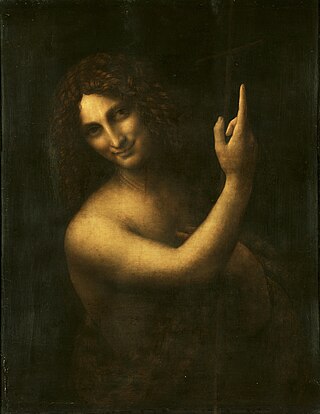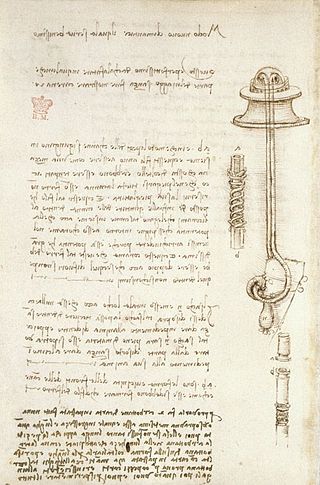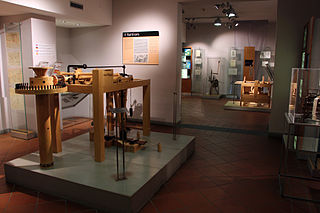
The Codex Leicester is a collection of scientific writings by Leonardo da Vinci. The codex is named after Thomas Coke, Earl of Leicester, who purchased it in 1717. The codex provides an insight into the inquiring mind of the definitive Renaissance artist, scientist and thinker, as well as an exceptional illustration of the link between art and science and the creativity of the scientific process.

Francesco Melzi, or Francesco de Melzi (1491–1570), was an Italian painter born into a family of the Milanese nobility in Lombardy. He became a pupil of Leonardo da Vinci and remained as his closest professional assistant throughout his career. After da Vinci's death he became the literary executor of all da Vinci's papers, editing them into a manuscript on painting he published as Tratatto della Pittura [Treatise on Painting] or a compilation entitled the Codex Urbinas.

The Castello Sforzesco is a medieval fortification located in Milan, Northern Italy. It was built in the 15th century by Francesco Sforza, Duke of Milan, on the remnants of a 14th-century fortification. Later renovated and enlarged, in the 16th and 17th centuries it was one of the largest citadels in Europe. Extensively rebuilt by Luca Beltrami in 1891–1905, it now houses several of the city's museums and art collections.

Saint John the Baptist is a High Renaissance oil painting on walnut wood by Leonardo da Vinci. Likely to have been completed between 1513 and 1516, it is believed to be his final painting. Its original size was 69 by 57 centimetres.

The Codex Atlanticus is a 12-volume, bound set of drawings and writings by Leonardo da Vinci, the largest single set. Its name indicates the large paper used to preserve original Leonardo notebook pages, which was used for atlases. It comprises 1,119 leaves dating from 1478 to 1519, the contents covering a great variety of subjects, from flight to weaponry to musical instruments and from mathematics to botany. This codex was gathered in the late 16th century by the sculptor Pompeo Leoni, who dismembered some of Leonardo's notebooks in its formation. It is now in the Biblioteca Ambrosiana in Milan.

Divina proportione, later also called De divina proportione is a book on mathematics written by Luca Pacioli and illustrated by Leonardo da Vinci, completed by February 9th, 1498 in Milan and first printed in 1509. Its subject was mathematical proportions and their applications to geometry, to visual art through perspective, and to architecture. The clarity of the written material and Leonardo's excellent diagrams helped the book to achieve an impact beyond mathematical circles, popularizing contemporary geometric concepts and images.

Codex on the Flight of Birds is a relatively short codex from c. 1505 by Leonardo da Vinci.

Mario Taddei is an Italian academic. He is an expert in multimedia and edutainment for museums, a Leonardo da Vinci devotee and scholar, and an expert in the codexes and machines of da Vinci and ancient books of technology.

The Royal Library of Turin is a library located within the ground floor of the Royal Palace of Turin, itself a World Heritage Site in Turin, Italy.

A Treatise on Painting is a collection of Leonardo da Vinci's writings entered in his notebooks under the general heading "On Painting". The manuscripts were begun in Milan while Leonardo was under the service of Ludovico Sforza and gathered together by his heir Francesco Melzi. An abridged version of the treatise was first published in France in 1651. After Melzi's manuscript was rediscovered in the Vatican Library, the treatise was published in its modern form in 1817.

Codex Arundel, is a bound collection of pages of notes written by Leonardo da Vinci and dating mostly from between 1480 and 1518. The codex contains a number of treatises on a variety of subjects, including mechanics and geometry. The name of the codex came from the Earl of Arundel, who acquired it in Spain in the 1630s. It forms part of the British Library Arundel Manuscripts.

Leonardo's crossbow designs are a series of shooting weapon schematics designed by Leonardo da Vinci that are in the Codex Atlanticus. One version, a self-spanning infantry weapon called the Rapid Fire Crossbow, is found on sheets 143r, 153r, and 155r. The other is the Giant Crossbow design intended to be a mounted siege weapon found on sheet 149a in the Codex.

Gian Giacomo Caprotti da Oreno, better known as Salaì was an Italian artist and pupil of Leonardo da Vinci from 1490 to 1518. Salaì entered Leonardo's household at the age of ten. He created paintings under the name of Andrea Salaì. He was described as one of Leonardo's students and lifelong companion and servant and was the model for Leonardo's St. John the Baptist,Bacchus and Angelo incarnato.
Carlo Pedretti was an Italian historian. In his lifetime, he was considered one of the world's leading experts on the life and works of Leonardo da Vinci. He was a professor of art history and Armand Hammer Chair in Leonardo Studies at the University of California, Los Angeles from 1960 until his retirement in 1993.

The Madrid Codices I–II, are two manuscripts by Leonardo da Vinci which were discovered in the Biblioteca Nacional de España in Madrid in 1965 by Dr. Jules Piccus, Language Professor at the University of Massachusetts. The Madrid Codices I was finished during 1490 and 1499, and II from 1503 to 1505.
Carlo Vecce is Professor of Italian Literature in the University of Naples "L'Orientale", he taught also in the University of Pavia, the D'Annunzio University of Chieti–Pescara and the University of Macerata. Abroad he was visiting professor at Paris 3 (2001) and University of California Los Angeles (UCLA) (2009).

The Museo Ideale Leonardo da Vinci is located in Vinci, Leonardo da Vinci's birthplace, in the province of Florence, Italy. It is part of the Museo leonardiano di Vinci.
Augusto Marinoni was professor of romance philology at the Università Cattolica del Sacro Cuore of Milan, a member of the Commissione Vinciana and the Accademia dei Lincei. He is considered one of the greatest scholars of Leonardo da Vinci.
Leonardo da Vinci is a 1997 interactive CD-ROM game by Corbis, consisting of a "computerized viewing tool which permits the user to examine English translations of the Codex [Leicester] superimposed onto facsimiles of its pages". The tool, known as Codescope, is licensed by Corbis.















